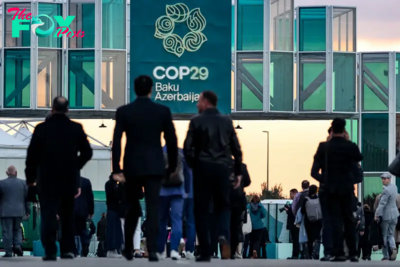World News
How Warmer Weather Could Fuel a Massive Epidemic in Gaza
Amid seemingly endless death, destruction, and displacement, life in Gaza has long been unbearable. At least 30,000 people have been killed and countless more wounded since the start of Israel’s retaliatory bombardment following Hamas’s Oct. 7 massacre. And the punishing winter weather, marked by heavy rain and temperatures as low as 48°F (9°C), has made the Strip all but uninhabitable for its more than 2 million inhabitants, many of whom were forced to flee their homes without warm clothes or blankets. Those who manage to find refuge in overcrowded shelters are considered the lucky ones. Others reside in makeshift tents, with nothing but tarpaulin and thin plastics to shield them from the elements.
While many may greet the arrival of spring as a much-needed reprieve from the cold, experts warn that the warmer temperatures come with their own set of challenges—ones that stand to make the situation in Gaza much worse. That’s because warmer weather, while beneficial in some respects, can accelerate the spread of communicable diseases, such as diarrhea and hepatitis A, even as it reduces the risk of others. “As the season changes to spring and summer, you will have a lower incidence of certain infectious diseases: the flu, COVID-19, other respiratory viruses that affect children,” says Francesco Checchi, an epidemiologist at the London School of Hygiene & Tropical Medicine specializing in disease control in crisis. “That’s just a seasonal effect that would happen in any given year—and that’s perhaps the only plus that I can cite.”
Read More: Gaza Is Being Starved. Could Airdropping Food Be the Answer?
Among Checchi’s top concerns is that warmer weather could even lead to a cholera outbreak. “Something like cholera, if introduced into the Gaza Strip, would result in a really massive epidemic for the reasons you can imagine: It would be extremely transmissible because people are living on top of each other, there’s not enough water, not enough sanitation,” he says, noting that Gaza’s decimated Health care system doesn’t have the resources to cope with illnesses that require extensive rehydration. The few Health facilities that still remain are well past breaking point.
“It’s the perfect environment for a massive epidemic to take hold,” Checchi warns. “And perhaps we’ve just been a little lucky so far that one hasn’t.”

Perhap the most acute crisis is the dire lack of food and other humanitarian aid entering the Strip—conditions that the U.N. and others have warned will make famine “almost inevitable.” The level of desperation that the people of Gaza are facing was underscored on Feb. 29, when more than 100 Palestinians were killed and hundreds more wounded trying to access a rare aid convoy in northern Gaza, which has been all but cutoff from humanitarian aid. While Palestinian officials attributed the bulk of the casualties to the Israeli Military, which reportedly opened fire on the crowds converging on the convoy, the Israeli Military attributed the extent of the casualties to a stampede. An investigation by the Washington Post, which included video and eyewitness accounts of the event, reported that “the real panic didn’t start until Israeli soldiers and tanks began firing, hitting civilians and sparking a stampede.” Leaders in the E.U., the U.K., France, and Germany have called for an independent investigation into the incident.
Read More: How World Leaders Have Reacted to the Deaths of People In Gaza Waiting For an Aid Convoy
While the U.S. joined other countries in airdropping tens of thousands of meals over the Strip over the weekend in an effort to stymie the hunger crisis, humanitarian organizations warn that airdrops alone will not be enough to meet the extensive needs of Gaza’s population. “Airdrops are not the solution to relieve this suffering, and distract time and effort from proven solutions to help at scale,” the International Rescue Committee said in a statement. “All diplomatic focus should be on ensuring Israel lifts its siege of Gaza, reopens its crossings [...] and allows the safe and unimpeded movement of humanitarian aid—including fuel, food, and medical supplies—and for aid workers and medical personnel to aid sick and wounded people.”
Fozia Alvi, a Canadian physician who recently returned from a medical trip to Gaza through her aid group Humanity Auxilium, tells TIME that she witnessed children who had symptoms of severe malnutrition, including some who she believes were suffering from rickets, a condition that often stems from dietary deficiencies. She also saw fungal infections and hepatitis A, the spread of which she attributed to widespread overcrowding. “The children and the adults who escaped the bombing and sniper shots, they will die from the diseases,” Alvi says, referencing the more than 1 million Palestinians who fled to Gaza’s southern cities of Khan Younis and Rafah, where she was based. “These are all things that we can prevent if we had the means to.”

This mix of malnutrition and disease can result in a vicious cycle, Checchi warns, noting that children who are acutely malnourished are extremely vulnerable to infection. Indeed, at least 90% of children under the age of five in Gaza have been affected by one or more infectious diseases, according to UNICEF, the U.N. children’s agency. Some 70% have suffered from diarrhea in the two weeks preceding its Feb. 19 report, a 23-fold increase from the 2022 baseline. At least 15 children have already died as a result in recent days, according to Gaza’s Health ministry.
“A child who is acutely malnourished usually will die of an infectious disease; not of starvation,” Checchi says. “I’m just worried that we’ll see rates of malnutrition that are consistent with some of the worst famines ever described.”
This threat has prompted widespread alarm among humanitarian organizations and governments alike, many of which are now calling for a ceasefire to address the ongoing catastrophe, particularly in advance of Israel’s anticipated invasion of Gaza’s southernmost city of Rafah, where the vast majority of the Strip’s population currently resides.
Checchi says that even a three-week pause, albeit insufficient, could at least allow Health experts to do a cholera vaccination campaign, for example—something that he says would require allowing humanitarian groups to bring food and medicine into the Strip and to circulate freely within it, neither of which is currently possible. At a bare minimum, he adds, people in Gaza need to have their basic food and water needs met, the latter of which is expected to increase as temperatures get warmer. “Even if things stay exactly as they are,” he says, “the number of children falling into acute and severe acute malnutrition will exponentially increase, and I would expect that the burden of infectious diseases will do as well.”
In a recent study conducted by the London School of Hygiene & Tropical Medicine and Johns Hopkins University, Checchi and his co-authors project that, even in the absence of epidemics, an additional 58,260 Palestinians will be killed over the next six months if things remain unchanged. That figure jumps up to 74,290 in the event of an escalation.
“The way things are heading right now is consistent with our worst scenario,” Checchi says, perhaps “even a little bit worse than that.”
-

 World News8h ago
World News8h agoUNWRA Chief Philippe Lazzarini on the U.N. Agency’s Future in Gaza
-

 World News19h ago
World News19h agoBrazilian Police Indict Former President Bolsonaro for Alleged Attempted Coup
-

 World News1d ago
World News1d agoThe Future of Climate Action Is Trade Policy
-

 World News1d ago
World News1d agoWorld’s Best Brands – Brazil
-

 World News2d ago
World News2d agoWorld’s Best Brands – India
-

 World News2d ago
World News2d agoInternational Criminal Court Issues Arrest Warrants for Netanyahu and Hamas Commander
-

 World News3d ago
World News3d agoLandmark Bill to Ban Children From Social Media Introduced in Australia’s Parliament
-

 World News3d ago
World News3d agoAmerican and Australian Tourists Die in Laos After Drinking Tainted Alcohol

















